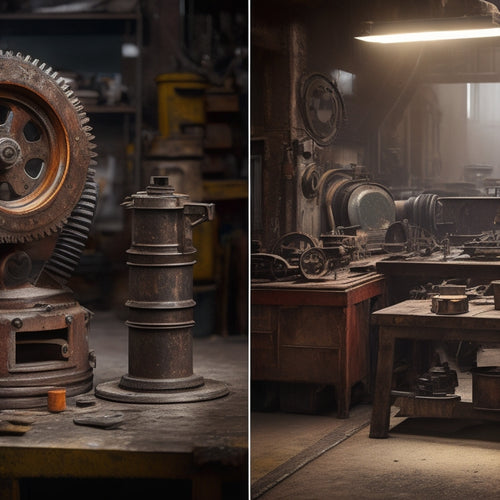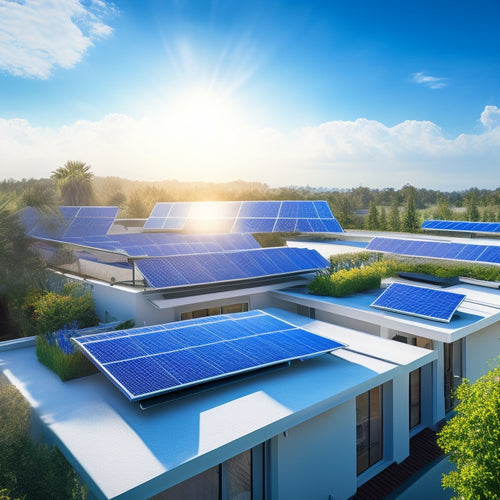
Designing the Perfect Home Solar Panel System
Share
To design the perfect home solar panel system, you'll need to accurately assess your energy needs, considering your daily energy usage, energy audits, and historical consumption patterns. Next, choose the right panel type, evaluating efficiency, power output, and durability. Then, determine the best system size and installation, factoring in roof size constraints, energy efficiency goals, and local building codes. By following these steps, you'll be well on your way to maximizing your solar panel system's potential. As you continue to fine-tune your system, you'll discover the key to unleashing a sustainable and cost-effective energy future.
Key Takeaways
• Assess energy needs by calculating daily energy usage in watt-hours and conducting an energy audit to identify inefficiencies.
• Choose the right solar panel type by considering efficiency, power output, durability, and cost to ensure maximum energy harvesting.
• Determine the ideal system size by calculating total daily energy usage, peak sun hours, and shading analysis to ensure optimal performance.
• Ensure proper system installation by assessing roof size constraints, optimizing roof space, and minimizing shading obstacles for maximum energy production.
• Regular maintenance checks, including seasonal checks and inverter monitoring, are essential to prevent costly repairs and system failure.
Assessing Your Energy Needs
To determine the size and configuration of your ideal solar panel system, you must first calculate your total daily energy usage in watt-hours (Wh), taking into account the appliances, lighting, and devices that will be powered by your system. This is important in ensuring your solar panel system meets your energy demands.
Conducting an energy audit will help you identify areas of energy inefficiency and opportunities for improvement. Reviewing your historical consumption patterns will also provide valuable insights into your energy usage habits. By analyzing your energy usage data, you'll be able to pinpoint which appliances and devices consume the most energy and adjust your usage habits accordingly.
This information will enable you to accurately size your solar panel system, ensuring it can handle your energy requirements. A thorough energy audit will help you identify opportunities to reduce your energy consumption, making your solar panel system more efficient and cost-effective.
Choosing the Right Panel Type
When choosing the ideal solar panel type for your home, you'll need to assess the trade-offs between efficiency and power output, panel durability and lifespan, and cost and budget considerations.
You'll want to evaluate how much electricity you need to generate, as well as the available roof space and local building codes.
Efficiency and Power Output
Your solar panel system's efficiency and power output largely depend on the type of panel you choose, with high-efficiency panels capable of producing up to 23% more power per hour of sunlight than their standard counterparts.
When selecting a panel, you'll want to take into account the power output, measured in watts (W), and the efficiency rating, typically expressed as a percentage. Higher-efficiency panels allow for maximum energy harvesting, even in limited roof space.
To enhance panel performance, consider the temperature coefficient, which affects energy production as temperatures rise. Look for panels with a low temperature coefficient to minimize energy losses.
Additionally, take into account the fill factor, which indicates how efficiently the panel converts sunlight into electricity. A higher fill factor means more energy harvested per hour of sunlight.
Panel Durability and Lifespan
Reliability and longevity are crucial considerations when selecting a solar panel system, as a durable panel can withstand harsh environmental conditions and maintain its performance over a lengthy lifespan. You want a system that can withstand the test of time and the elements.
When evaluating panel durability, consider the environmental factors that'll affect your system's performance. Temperature fluctuations, humidity, and exposure to UV rays can all impact your panel's lifespan.
Look for panels that have undergone rigorous material testing, such as accelerated lifetime testing, thermal cycling, and humidity freeze tests. These tests simulate real-world environmental stresses, ensuring the panels can withstand the elements. A reputable manufacturer will provide detailed reports on their testing procedures and results.
You should also look for certifications from organizations like the International Electrotechnical Commission (IEC), which set standards for solar panel durability. By choosing a durable panel that's been thoroughly tested, you'll enjoy a longer lifespan and optimal performance from your solar panel system.
Cost and Budget Considerations
As you navigate the solar panel market, you'll quickly realize that cost and budget considerations play a vital role in choosing the right panel type for your home solar system. The upfront cost of solar panels can be substantial, but it's important to take into account the long-term benefits and potential savings.
When evaluating your budget, explore financing options that can help spread the cost over time. Many solar panel manufacturers and installers offer financing plans or partnerships with lenders to make solar energy more accessible.
Additionally, take advantage of government incentives, such as the Solar Investment Tax Credit (ITC), which allows homeowners to claim a tax credit of up to 26% of the total system cost. State and local governments may also offer rebates or incentives for solar installations. By factoring in these incentives, you can significantly decrease the upfront cost of your solar panel system.
When choosing a panel type, consider the cost per watt, efficiency, and durability to make sure you're getting the best value for your investment. By carefully evaluating your budget and exploring available incentives, you can design a home solar panel system that meets your energy needs and fits your budget.
Determining System Size Requirements
To accurately determine your solar panel system's size requirements, you'll need to calculate your total daily energy usage in watt-hours, taking into account the appliances and devices you plan to power. This load calculation involves conducting an energy audit to identify areas of high energy consumption in your home.
Next, you'll need to take into account the peak sun hours your location receives, as this will impact the system's energy production. A shading analysis will also be necessary to evaluate how nearby objects may affect your system's performance. Additionally, you'll need to assess your roof's geometry to guarantee a suitable installation.
By taking into consideration these factors, you can determine the ideal system size for your specific needs. A scalable system design will also ensure that your system can adapt to future changes in your energy usage.
Understanding Roof Size Constraints
Your roof's physical constraints, including its size, shape, and orientation, play an important role in determining the maximum number of solar panels you can install, so it's crucial to assess these factors before designing your system.
A thorough assessment will help you identify potential roof obstructions, such as vents, skylights, or chimneys, that could limit the available space for solar panels.
When evaluating your roof's size constraints, take into account the total square footage and the amount of usable space available for solar panels. You'll also need to take into consideration the roof's orientation, as a south-facing roof receives the most sunlight and is ideal for solar panels.
If your roof has multiple orientations, you may need to use specialized racking systems to accommodate the different angles.
Calculating Energy Efficiency Goals
You need to determine how much energy you want your solar panel system to produce to offset your energy consumption, and this calculation hinges on your energy efficiency goals. To achieve this, you'll need to assess your current energy usage and identify areas for improvement.
Conducting an energy audit will help you pinpoint energy-wasting habits and opportunities to reduce your carbon footprint.
Here are some key considerations to help you calculate your energy efficiency goals:
- Energy usage patterns: Analyze your past energy bills to identify peak usage times and seasonal variations.
- Appliance efficiency: Identify opportunities to replace inefficient appliances with energy-efficient alternatives.
- Home insulation and sealing: Make sure your home is well-insulated and sealed to minimize heat loss and gain.
- Behavioral changes: Consider adopting energy-saving habits, such as turning off lights and electronics when not in use.
Selecting the Ideal Inverter Type
When it comes to harnessing the power of your solar panel system, the inverter plays a crucial role in converting DC power from the panels into AC power for your home, making the right inverter selection a key component of a successful installation.
As you evaluate your inverter options, you'll want to focus on inverter sizing. This involves determining the best inverter capacity to match your solar panel array's power output. A properly sized inverter ensures maximum energy harvesting and minimizes energy losses.
Additionally, you'll need to confirm that your inverter meets grid compliance standards, such as UL 1741 and IEEE 1547, to safely and efficiently feed excess energy back into the grid. You'll also want to take into account the inverter's efficiency rating, monitoring capabilities, and warranty terms.
Evaluating Battery Storage Options
As you contemplate integrating energy storage into your solar panel system, evaluating battery storage options becomes a critical step in optimizing your energy independence and resilience. With the increasing adoption of renewable energy, achieving Grid Parity is now more feasible than ever.
When selecting a battery storage solution, it's vital to take into account key factors that impact performance and longevity.
Here are some key considerations when assessing battery storage options:
-
Depth of Discharge (DOD): A higher DOD means more usable energy, but may reduce the battery's Cycle Life.
-
Cycle Life: Evaluate the battery's lifespan in terms of charge/discharge cycles to ensure it meets your energy needs.
-
Round-Trip Efficiency: Seek high efficiency ratings to minimize energy losses during charging and discharging.
- Compatibility and Integration: Ensure smooth integration with your solar panel system and inverter type.
Considering Local Building Codes
Local building codes and ordinances play an essential role in determining the feasibility and installation requirements of your home solar panel system. As you design your system, it's important to take into account the local regulations that govern solar installations in your area.
Zoning regulations, for instance, may dictate the size and placement of your solar panels, while permitting requirements will influence the installation process. You'll need to research and adhere to local building codes, which may vary depending on your location.
Some jurisdictions may have specific requirements for roof-mounted systems, while others may have restrictions on the type of equipment used. Permitting requirements will also come into play, as you'll need to obtain the necessary permits before commencing installation.
Failure to comply with these regulations can result in costly delays, fines, or even system removal. To avoid these issues, consult with local authorities and solar professionals to ensure your system meets all necessary standards. By doing so, you'll guarantee a smooth and successful installation process.
Maximizing Roof Space Efficiency
You'll want to optimize your roof's available space to accommodate the maximum number of solar panels, making sure your system generates the most energy possible while minimizing costs.
To achieve this, consider the following key factors:
-
Roof Orientation: Guarantee your solar panels are installed at an ideal angle to maximize energy production, taking into account your roof's pitch and direction.
-
Shading Analysis: Identify potential shading obstacles, such as trees or neighboring buildings, and strategically place panels to minimize energy losses.
-
Panel Clustering: Group panels together to reduce wiring and connection costs, while also enhancing system efficiency.
- Aesthetic Integration and Obstruction Management: Balance the need for maximum energy production with the importance of maintaining a visually appealing roofline, while also managing obstructions like vents, skylights, or chimneys.
Ensuring System Durability Longevity
When designing your home solar panel system, you'll want to make sure it can withstand the elements and last for years to come. To achieve this, you'll need to focus on three key areas:
-
Selecting high-quality components that can resist degradation.
-
Testing your system's weather resistance.
-
Scheduling regular maintenance to catch any potential issues early.
High-Quality Component Selection
Choosing high-quality components for your solar panel system is essential to guaranteeing its durability and longevity, as inferior parts can greatly compromise your system's performance and lifespan. When selecting components, it's vital to evaluate the warranty offered by the manufacturer. A thorough warranty that covers parts and labor for an extended period is a hallmark of a reputable supplier.
To make sure you're getting high-quality components, consider the following factors:
-
Supplier credibility: Research the manufacturer's reputation, checking for certifications, industry recognition, and customer reviews.
-
Warranty evaluation: Carefully review the warranty terms, including the length of coverage, coverage limits, and maintenance requirements.
-
Component durability: Look for components built with durable materials and designed to withstand environmental stressors.
- Third-party certifications: Ensure that components meet industry standards, such as those set by the International Electrotechnical Commission (IEC).
Weather Resistance Testing
By subjecting your solar panel system to rigorous weather resistance testing, you validate that it can withstand the harshest environmental conditions, thereby ensuring its durability and longevity. This exhaustive testing process simulates extreme weather scenarios, exposing your system to saltwater exposure, extreme temperature fluctuations, and other harsh conditions. By doing so, you confirm that your system can operate efficiently and reliably, even in the face of severe weather events.
During testing, your system will be subjected to simulated storms, heavy rainfall, and extreme temperature fluctuations, ranging from -40°C to 85°C. This thorough testing protocol helps identify potential weaknesses in your system's design, allowing you to make necessary adjustments before installation.
Regular Maintenance Scheduling
To guarantee your solar panel system operates at peak performance and longevity, you must schedule regular maintenance checks, tackling issues before they escalate into costly repairs or even system failure. Regular maintenance is vital to ensuring your system's durability and longevity. By implementing preventive measures, you'll avoid unexpected downtime and maximize your energy output.
Here are some essential maintenance tasks to include in your schedule:
-
Seasonal Checks: Perform inspections at the start of each season to make sure your system is adapted to changing weather conditions.
-
Inverter Monitoring: Regularly check inverter performance to prevent energy losses and identify potential faults.
-
Panel Cleaning: Clean your solar panels regularly to maintain top energy absorption.
- Grounding and Bonding: Verify that your system's grounding and bonding are secure to prevent electrical shocks and fires.
Frequently Asked Questions
How Do I Ensure My System Is Compatible With My Utility Company?
You'll need to confirm that your system is compatible with your utility company by understanding their Utility Billing policies and Net Metering programs, then verifying their technical requirements to guarantee a seamless interconnection.
Can I Add More Panels to My Existing Solar Panel System?
You can upgrade your existing system by adding more panels, but first, you'll need to evaluate your system's compatibility with panel upgrades and make sure the inverter can handle the increased power output during a system expansion.
What Happens to Excess Energy Generated by My Solar Panels?
"When your solar panels generate excess energy, you can either store it in energy storage systems or feed it back into the grid, earning you grid credits that offset your future energy bills."
Are There Any Solar Panel System Maintenance Requirements?
'As you bask in the triumphant glow of your newly installed solar panel system, remember to schedule regular panel cleaning, system monitoring, and battery inspections to guarantee peak performance and longevity, lest your green energy dreams turn to dust.'
Can I Install a Solar Panel System on a Metal Roof?
You can install solar panels on a metal roof, but make sure metal compatibility and proper roof preparation by cleaning and inspecting the surface, checking for rust or corrosion, and using compatible mounting systems.
Related Posts
-

Why Higher Upfront Costs Are Worth It
You pay a premium for high-quality, energy-efficient products, but they're worth it. With durability testing ensuring...
-

What You Need to Know About RV Solar Maintenance
When you're out on the road, your RV's solar panel system is your lifeline. But without regular maintenance, you're l...
-

Best Solar Panel Options for Maximum Energy Savings
You can maximize your energy savings with solar panels that boast efficiency ratings above 20%, paired with extensive...


